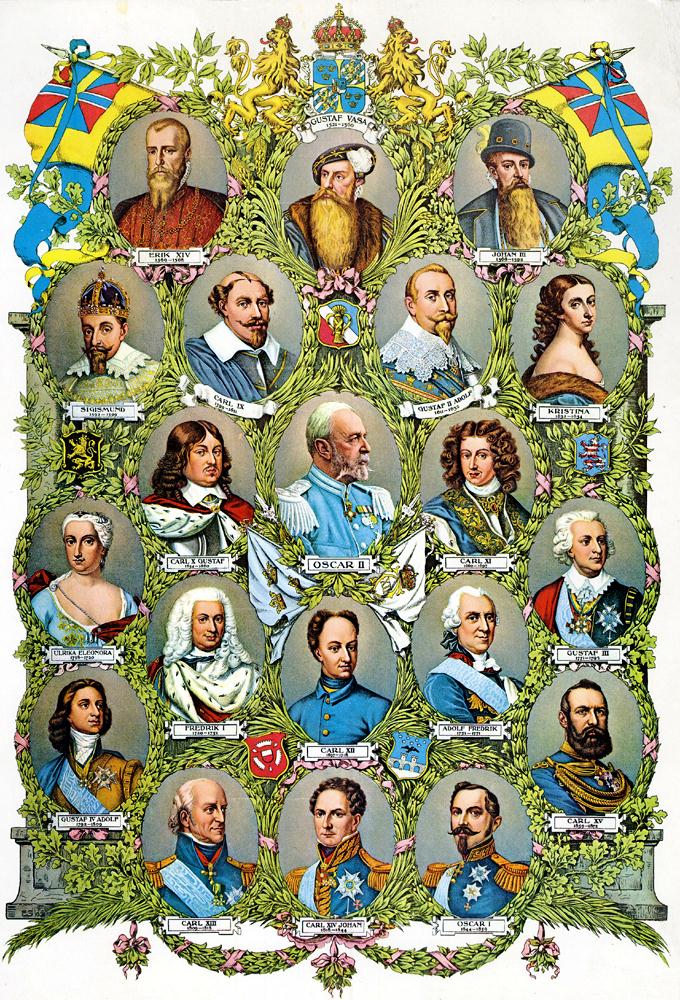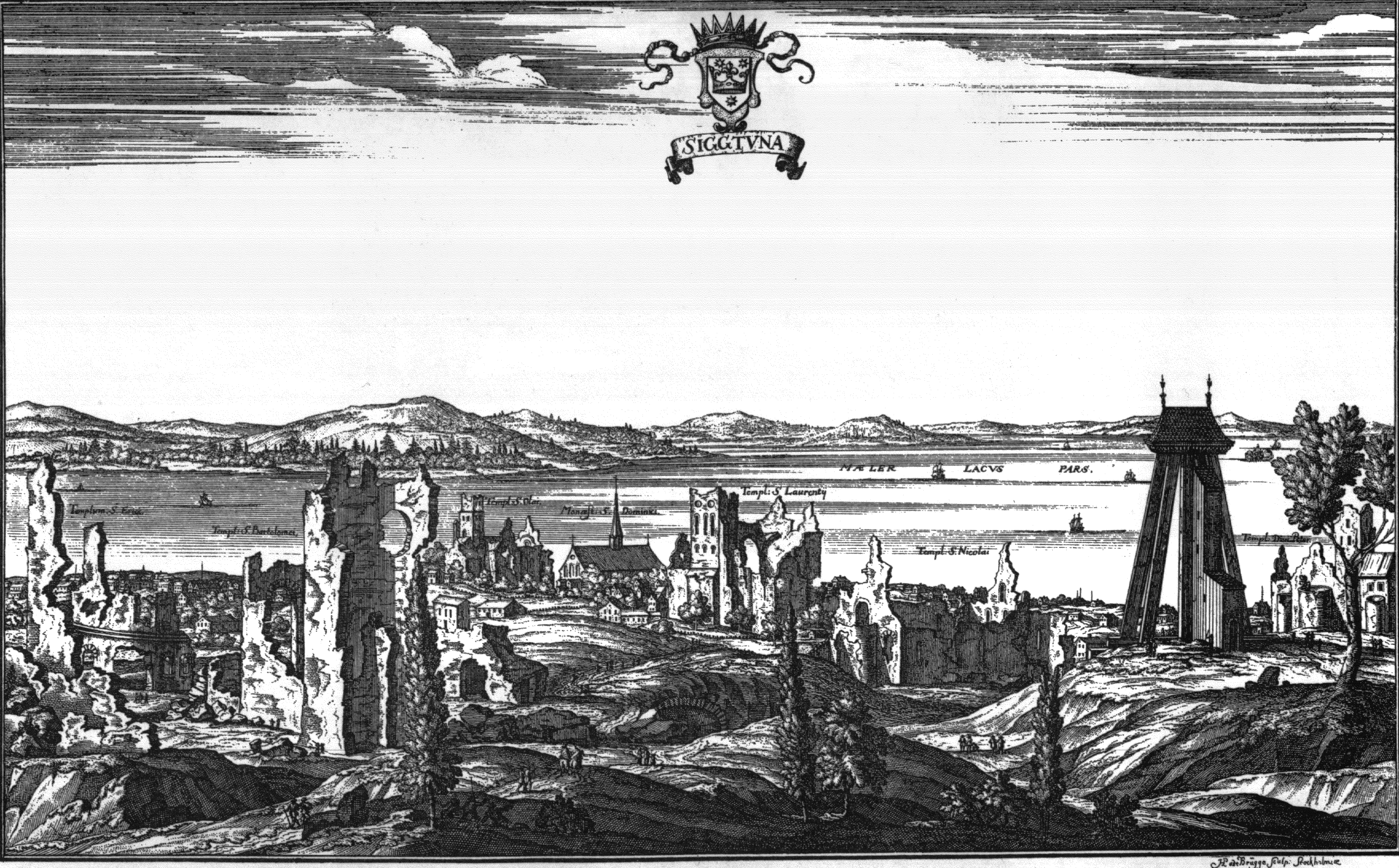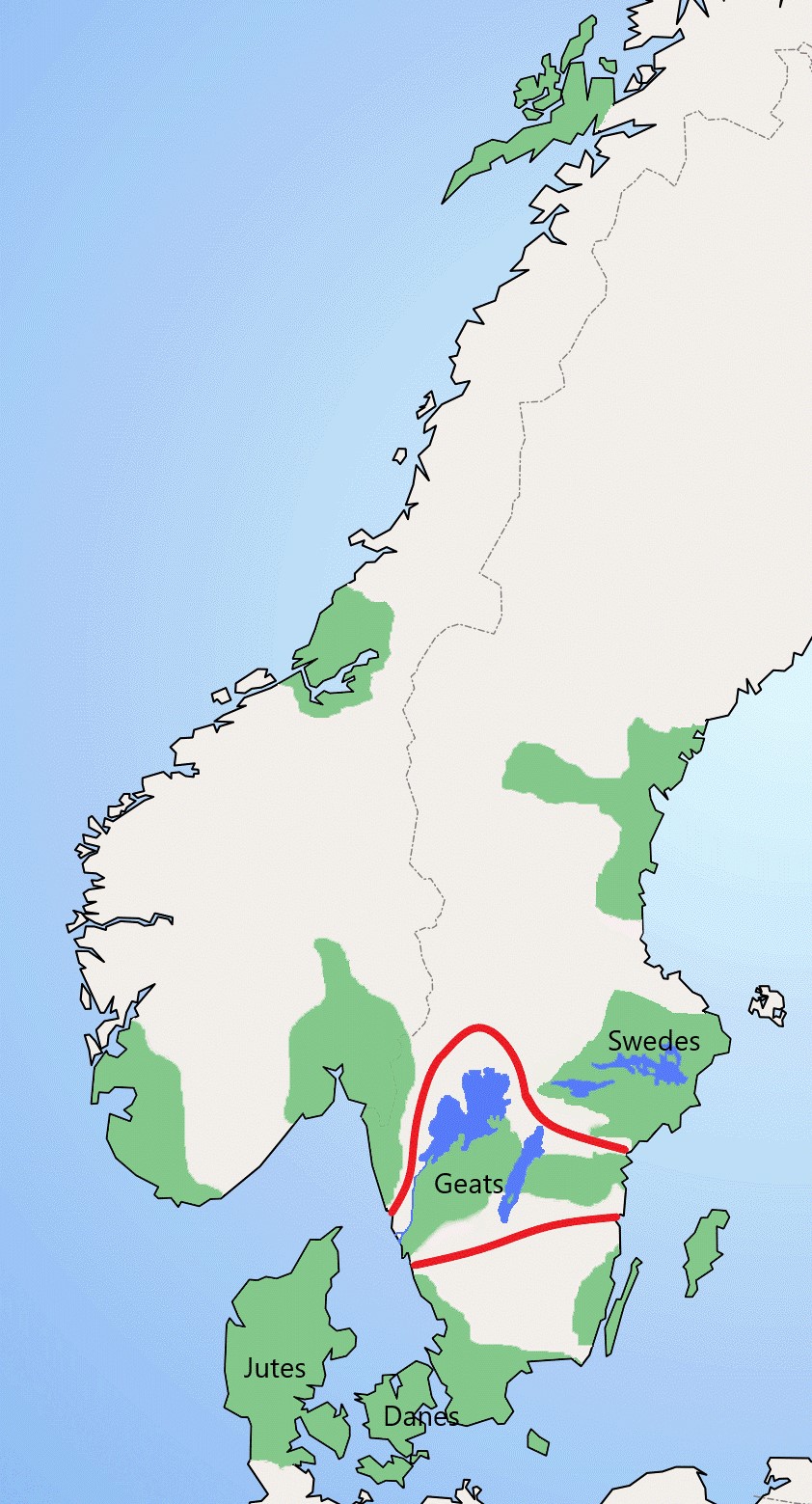|
Emund Eriksson
Emund Eriksson (?-c. 970), (English: Edmund), was a Swedish king whose historicity is only known from a single source, the Gesta Hammaburgensis ecclesiae pontificum which was written by Adam of Bremen in c. 1075. Reign According to Adam of Bremen, a certain King Ring ruled the Swedes together with his sons Erik and Emund in about 936. In a later chapter, Adam mentions Emund Eriksson as ruling Sweden some time in the second half of the 10th century. He was presumably the son of Erik Ringsson. Adam relates that Emund was king at the same time as King Harald Bluetooth of Denmark (c. 958/64-985) expanded his power overseas and subdued Norway (in about 970). Emund was an ally of Harald, and showed a friendly attitude to Christian people who came to him. That German missionary efforts were renewed about this time is related by Adam in the following chapter. The Archbishop of Hamburg-Bremen, Adaldag (937-988), appointed a Dane called Odinkar the Elder for the Swedish lands. Being a pious ... [...More Info...] [...Related Items...] OR: [Wikipedia] [Google] [Baidu] |
List Of Swedish Monarchs
This is a list of Swedish kings, queens, regents and viceroys of the Kalmar Union. History The earliest record of what is generally considered to be a Swedish king appears in Tacitus' work ''Germania (book), Germania'', c. 100 AD (the king of the Suiones). However, due to scant and unreliable sources before the 11th century, lists of succession traditionally start in the 10th century with king Olof Skötkonung, and his father Eric the Victorious, who also were the first Swedish kings to be baptized. There are, however, lists of Swedish pagan monarchs with far older dates, but in many cases these kings appear in sources of disputed historical reliability. These records notably deal with the legendary House of Yngling, and based on the Danish chronicler Saxo Grammaticus, Eric the Victorious and Olof Skötkonung have often been classified as belonging to the Swedish house of Ynglings, tracing them back to Sigurd Hring and Ragnar Lodbrok (whom Saxo considered to belong to the House o ... [...More Info...] [...Related Items...] OR: [Wikipedia] [Google] [Baidu] |
Sweyn Estridsen
Sweyn Estridsson Ulfsson ( on, Sveinn Ástríðarson, da, Svend Estridsen; – 28 April 1076) was King of Denmark (being Sweyn II) from 1047 until his death in 1076. He was the son of Ulf Thorgilsson and Estrid Svendsdatter, and the grandson of Sweyn Forkbeard through his mother's line. He was married three times, and fathered 20 children or more out of wedlock, including the five future kings Harald Hen, Canute the Saint, Oluf Hunger, Eric Evergood, and Niels. He was courageous in battle, but did not have much success as a military commander. His skeleton reveals that he was a tall, powerfully built man who walked with a limp. Biography Accession to the throne Sweyn was born in England, Bricka, Carl Frederik, ''Dansk Biografisk Lexikon'', vol. XVII vend Tveskjæg – Tøxen 1903pp.3–5 as the son of Ulf Thorgilsson and Estrid Svendsdatter, the latter of whom was the daughter of King Sweyn I Forkbeard and sister of Kings Harald II and Canute the Great. Sweyn grew up a m ... [...More Info...] [...Related Items...] OR: [Wikipedia] [Google] [Baidu] |
Semi-legendary King Of Sweden
The legendary kings of Sweden () according to legends were rulers of Sweden and the Swedes who preceded Eric the Victorious and Olof Skötkonung, the earliest reliably attested Swedish kings. Though the stories of some of the kings may be embellished tales of local rulers or chiefs that actually existed. For example, Hygelac (500 A.D.) is believed to have historical basis due to his name being attested in Frankish, English, Danish and Icelandic sources. But the historicity of most legendary kings remains impossible to verify due to a lack of sources.Dick, Harrison 2011 http://blog.svd.se/historia/2011/10/13/varfor-jag-inte-tror-pa-sagokungar/ The modern Swedish monarchy considers Eric the Victorious to have been the first King of Sweden. In medieval Swedish lists of kings, the figure generally represented as the first king of Sweden is Olof Skötkonung, the first Christian king of Sweden and the first Swedish king to mint coins. The earlier kings are for the most part only attes ... [...More Info...] [...Related Items...] OR: [Wikipedia] [Google] [Baidu] |
Early Swedish History
{{disambiguation, geo ...
Early may refer to: History * The beginning or oldest part of a defined historical period, as opposed to middle or late periods, e.g.: ** Early Christianity ** Early modern Europe Places in the United States * Early, Iowa * Early, Texas * Early Branch, a stream in Missouri * Early County, Georgia Other uses * ''Early'' (Scritti Politti album), 2005 * ''Early'' (A Certain Ratio album), 2002 * Early (name) * Early effect, an effect in transistor physics * Early Records, a record label * the early part of the morning See also * Earley (other) Earley is a town in England. Earley may also refer to: * Earley (surname), a list of people with the surname Earley * Earley (given name), a variant of the given name Earlene * Earley Lake, a lake in Minnesota *Earley parser, an algorithm *Earley ... [...More Info...] [...Related Items...] OR: [Wikipedia] [Google] [Baidu] |
Diarchy
Diarchy (from Greek , ''di-'', "double", and , ''-arkhía'', "ruled"),Occasionally misspelled ''dyarchy'', as in the ''Encyclopaedia Britannica'' article on the colonial British institution duarchy, or duumvirate (from Latin ', "the office of the two men"). is a form of government characterized by corule, with two people ruling a polity together either lawfully or ''de facto'', by collusion and force. The leaders of such a system are usually known as corulers. Historically, ''diarchy'' particularly referred to the system of shared rule in British India established by the Government of India Acts 1919 and 1935, which devolved some powers to local councils, which had included native Indian representation under the Indian Councils Act 1892. 'Duumvirate' principally referred to the offices of the various duumviri established by the Roman Republic. Both, along with less common synonyms such as biarchy and tandemocracy, are now used more generally to refer to any system of joi ... [...More Info...] [...Related Items...] OR: [Wikipedia] [Google] [Baidu] |
Eric Anundsson
Eric Anundsson or Eymundsson was a semi-legendary Swedish king who supposedly ruled during the 9th century. The Norse sagas describe him as successful in extending his realm over the Baltic Sea, but unsuccessful in his attempts of westward expansion. There is no near-contemporary evidence for his existence, the sources for his reign dating from the 13th and 14th centuries. These sources, Icelandic sagas, are generally not considered reliable sources for the periods and events they describe. Controversially, older Swedish historians have identified Eric with another legendary Swedish king, ''Erik Weatherhat'', who is mentioned in some medieval king-lists as the predecessor of Eric the Victorious. However, Saxo Grammaticus identifies Erik Weatherhat with another figure, a son of the legendary Viking Ragnar Lodbrok. Eric's reign He is given as the son of Anund Uppsale in the '' Hervarar saga'' (13th century): :''Eiríkr hét sonr Önundar konungs, er ríki tók eptir föður sinn ... [...More Info...] [...Related Items...] OR: [Wikipedia] [Google] [Baidu] |
Björn (III) Eriksson
Bjorn (English, Dutch), Björn (Swedish, Icelandic, Dutch, and German), Bjørn (Danish, Faroese and Norwegian), Beorn (Old English) or, rarely, Bjôrn, Biorn, or Latinized Biornus, Brum (Portuguese), is a Scandinavian male given name, or less often a surname. The name means "bear" (the animal). In Finnish and Finland Swedish, sometimes also in Swedish, the nickname Nalle ("teddy bear") refers to Björn. Surname *Claus Bjørn, Danish author, historian, and television and radio broadcaster * Evert Björn, Swedish Olympic athlete *Hugo Björne, Swedish actor * Kristian Bjørn, Norwegian skier * Lars "Lasse" Björn, Swedish Olympic ice hockey player *Thomas Bjørn, Danish golfer Given name Acting * Björn Andrésen, Swedish actor and musician *Björn Bjelfvenstam, Swedish actor * Björn Granath, Swedish actor * Björn Gustafsson, Swedish comedian and actor * Björn Kjellman, Swedish actor and singer * Björn Skifs, Swedish singer and actor Art and music *Björn Afzelius, Swedish ... [...More Info...] [...Related Items...] OR: [Wikipedia] [Google] [Baidu] |
Sigtuna
Sigtuna () is a locality situated in Sigtuna Municipality, Stockholm County, Sweden with 8,444 inhabitants in 2010. It is the namesake of the municipality even though the seat is in Märsta. Sigtuna is for historical reasons often still referred to as a ''stad''. Modern-day Sigtuna, a harbor town that was established around 980, developed approximately 4 kilometres east of Old Sigtuna (which, according to Norse mythology, was previously the home of Odin). Sigtuna has a medieval-style town centre with restaurants, cafes and small shops. The old church ruins, runic stones and the old main street (''Stora gatan'') are popular attractions for tourists, especially in the summertime. The small streets with low-built wooden houses lead up to several handicrafts shops and the old tiny town hall (''Sigtuna Rådhus''). There are restaurants and ''Sigtuna Stadshotell'', a hotel in the town centre. Geography Sigtuna is situated at the bay Skarven, stretching around Upplands-Bro a ... [...More Info...] [...Related Items...] OR: [Wikipedia] [Google] [Baidu] |
Mälaren Valley
The Mälaren Valley ( sv, Mälardalen), occasionally referred to as Stockholm-Mälaren Region (''Stockholm-mälarregionen''), is the easternmost part of Svealand, the catchment area of Lake Mälaren and the surrounding municipalities. The term is often used interchangeably for the extended capital region of Sweden as Stockholm is located at the lake's eastern end, at its outlet in the Baltic Sea. Extent and characteristics The Mälaren Valley, which never has been defined as an official region, has throughout Swedish history instead been shared by several provinces — Uppland, Södermanland, Västmanland, and Närke — and, in modern times, by several counties — Stockholm, Uppsala, Södermanland, Örebro, and Västmanland. In most cases, the Lake Hjälmaren region is included into the Mälaren Valley Region, if nothing else, for historical and cultural reasons. Notwithstanding this, most people in Sweden will have a clear notion of what characterises the Mälaren Valley, ... [...More Info...] [...Related Items...] OR: [Wikipedia] [Google] [Baidu] |
Geats
The Geats ( ; ang, gēatas ; non, gautar ; sv, götar ), sometimes called ''Goths'', were a large North Germanic tribe who inhabited ("land of the Geats") in modern southern Sweden from antiquity until the late Middle Ages. They are one of the progenitor groups of modern Swedes, along with Swedes (the tribe) and Gutes. The name of the Geats also lives on in the Swedish provinces of and , the Western and Eastern lands of the Geats, and in many other toponyms. The Swedish dialects spoken in the areas that used to be inhabited by Geats form a distinct group, '' Götamål''. Etymology The etymology of the name ''Geat'' (Old English ', from a Proto-Germanic *''Gautaz'', plural *''Gautōz'') is similar to that of ''Goths'' and '' Gutes'' (*''Gutô'', plural *''Gutaniz''). The names derive from ablaut grades of the Proto-Germanic word *''geutaną'', meaning "to pour". They have the literal meaning "they who pour their seed". (For more information see Goths § Etymology.) The ... [...More Info...] [...Related Items...] OR: [Wikipedia] [Google] [Baidu] |
Eric The Victorious
Eric the Victorious (Old Norse: ''Eiríkr inn sigrsæli'', Modern Swedish: ''Erik Segersäll''; c. 945 – c. 995) was a Swedish monarch as of around 970. Although there were earlier Swedish kings, he is the first Swedish king in a consecutive regnal succession, who is attested in sources independent of each other, and consequently Sweden's list of rulers usually begins with him. His son Olof Skötkonung, however, is considered the first ruler documented to definitely have been accepted both by the original Swedes around Lake Mälaren and by the Geats around Lake Vättern. Adam of Bremen reports a king named Emund Eriksson before Eric, but it is not known whether he was Eric's father. The Norse sagas' accounts of a Björn Eriksson are considered unreliable. Some sources have referred to Eric the Victorious as either King ''Eric V'' or ''Eric VI'', modern inventions by counting backwards from Eric XIV (1560–1568), who adopted his numeral according to a 16th-century work on th ... [...More Info...] [...Related Items...] OR: [Wikipedia] [Google] [Baidu] |
Norse Saga
is a series of science fantasy role-playing video games by Square Enix. The series originated on the Game Boy in 1989 as the creation of Akitoshi Kawazu at Square. It has since continued across multiple platforms, from the Super NES to the PlayStation 2. The series is notable for its emphasis on open world exploration, non-linear branching plots, and occasionally unconventional gameplay. This distinguishes the games from most of Square's other franchises. Development The ''SaGa'' series was created by game designer Akitoshi Kawazu, whose contributions prior to the franchise's introduction include '' Final Fantasy'' and '' Final Fantasy II''. At a time when Nintendo's Game Boy was becoming popular worldwide due to the puzzle game '' Tetris'', then-Square president Masashi Miyamoto requested that a development team create a game for the handheld console. Kawazu and fellow designer Koichi Ishii suggested that the company develop a role-playing video game, thus making '' ... [...More Info...] [...Related Items...] OR: [Wikipedia] [Google] [Baidu] |






_p1.264_ERIK_SEGERSALL.jpg)